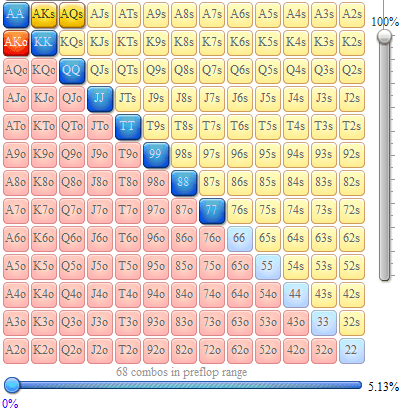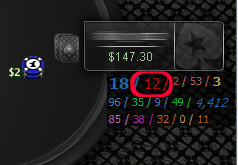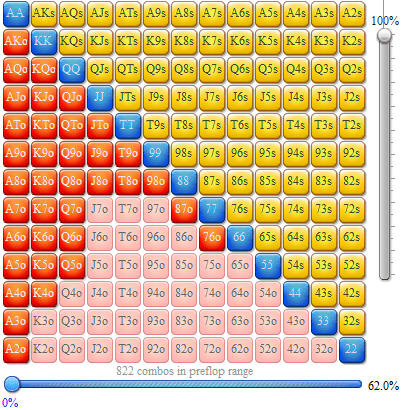Preflop betting tips. When the action reaches you before the flop, you will be faced with the decision to either fold, call or raise. If there has been no raise before you, then a call will simply mean matching the size of the big blind, which is also known as ‘ limping in '. Read any poker book and the simplified advice essentially boils down to 'raise preflop and if you get a single caller you should typically just fire a continuation bet on the flop.' Students read such a statement and extrapolate that to mean 'continuation bet 100% of the time' – and over time the issues of such an approach become clear.
Two different PLO HU modules covering the most common preflop strategies. Module A uses a pure raise/fold strategy from the SB. Module B uses a mixed strategy of limp/raise/fold from the SB. Covers both no-rake, mid-stakes (PLO200) and high-stakes (PLO500) rake levels. Casinos in blackhawk co. In contrast to Texas Hold'em, a well-balanced 3-bet strategy is hard to achieve for beginners. Contrary to NL, 3-bets in PLO generally get called. On the one hand this has to do with the preflop equities being closer together, and on other other hand many hands on the flop have a fundamentally different equity than preflop.
The Situation
1. Positions
2. Number of Players
This is absolutely crucial, especially at the lower limits. As soon as there are 3 or more players on the flop, the chances of bluff-raises occurring dramatically decrease. It can actually be good to throw out some flop-raises multi-way for this reason, we represent much more strength than in the heads-up situation. Players at slightly higher limits understand this and will have a default flop bluff-raising range in multi-way pots. In lower limits we can likely automatically fold any non-premium when facing a raise multi-way.3. Preflop Action
4. Initiative
5. Stack Sizes



Exploitative Play
The best decisions in any NLHE situation are going to be the exploitative ones. We should be making use of our opponents 'flop-raise-vs-cbet' stat. It's recommended that this is actually one of the stats included in our main HUD window and not buried in a popup somewhere. Inside the popup we can break it down in the following ways.- raise-vs-cbet-IP
- raise-vs-cbet-OOP (check/raise)
- raise-vs-cbet-TOTAL
- Overall flop-raise TOTAL (independent of initiative)
- Overall flop-raise IP
- Overall flop-raise OOP
- X/r after skip flop cbet (we can potentially place this in our cbet popup if preferred)
- The above stats for 3bet/4bet pots.
- 6% is probably the stone-cold nuts.
- 6-11% reasonably strong
- 12-17% good/aggressive (more bluffs than value, but this is correct strategy)
- 18% + You are probably being bluffed
Or imagine a guy who only calls PP's preflop. Should we assume that he is good/aggressive/balanced if he raises flop 12% of the time. Not at all, remember that we flop a set 12.5% of the time. He can easily reach 12% without ever bluffing if he doesn't understand how to play his sets on different board textures.
- Barrel-turn-after-raise-flop
- Barrel-river-after-raise-flop-bet-turn
- Raise-fold-flop-IP-OOP-TOTAL
Population Reads
Bet Sizing

Defending vs Aggressive Opponents
- We call with some mid-strength hands not strong enough to 3bet
- We slowplay some premiums that are strong enough to 3bet
- We defend with some back-door draws and regular draws which we will us as bluffs on later streets
- We 3bet our premiums for value (apart from those we slowplay)
- We 3bet some nutted draws to stack off with
- We 3bet some backdoor draws and weak draws which we can fold to a 4bet but will continue bluffing with if just called and we turn equity
Preflop, the two players seated to the left of the dealer must place required bets before any hand is dealt, which are known as the ‘blinds'. The player immediately to the left of the dealer is the ‘small blind' (SB), and the player to the left of the SB is the ‘big blind' (BB). After each hand, the position of the dealer, SB, and BB rotates around the table in a clockwise direction (to the left) for as long as the game goes on, giving all players the chance to be in these positions.
To start a new hand the SB and BB players must put out, or ‘post', their required blind amount, before the cards are dealt,. The blinds are forced bets and are required to remain in the pot. The blinds must be matched by the other players in order to keep and play their hands. The amount posted by the SB and BB will be used as a credit toward a call or raise from the players in the blind. (For instance, if no player raises the big blind, that player already has enough in the pot to see the flop for ‘free'.)
The first stage of the game is known as preflop.
Preflop Hand Chart
Once the SB and BB bets are placed in front of those players, the dealer will shuffle and deal each player two cards face down. Cards are to be dealt one at a time in a clockwise direction, from left to right.
The SB receives the first card and the player with the dealer button receives the last card. These are called the players' ‘hole cards' or ‘pocket cards'. Once all players receive their hole cards, the player seated next to the BB player begins the betting round.
Each player, in turn, may either ‘call' (match the current bet amount), ‘raise' (bet a larger amount, that is at least double the amount of the current bet), or ‘fold' (quit the hand, pushing their cards, face down, into the middle of the table, to be placed in a discard pile known as the ‘muck'.)
The minimum or lowest amount that can be bet must be equal to the amount posted by the big blind. Players can bet more than the minimum, this is called ‘raising'. If a player raises, that amount will be the new minimum for this round of betting.
Poker When To Raise Preflop Game
The betting continues around the table in a clockwise direction. When the action reaches the player in the small blind position, that player can either call the bet, by putting in additional chips to match the largest bet amount, or fold, forfeiting their chips to the pot.

Exploitative Play
The best decisions in any NLHE situation are going to be the exploitative ones. We should be making use of our opponents 'flop-raise-vs-cbet' stat. It's recommended that this is actually one of the stats included in our main HUD window and not buried in a popup somewhere. Inside the popup we can break it down in the following ways.- raise-vs-cbet-IP
- raise-vs-cbet-OOP (check/raise)
- raise-vs-cbet-TOTAL
- Overall flop-raise TOTAL (independent of initiative)
- Overall flop-raise IP
- Overall flop-raise OOP
- X/r after skip flop cbet (we can potentially place this in our cbet popup if preferred)
- The above stats for 3bet/4bet pots.
- 6% is probably the stone-cold nuts.
- 6-11% reasonably strong
- 12-17% good/aggressive (more bluffs than value, but this is correct strategy)
- 18% + You are probably being bluffed
Or imagine a guy who only calls PP's preflop. Should we assume that he is good/aggressive/balanced if he raises flop 12% of the time. Not at all, remember that we flop a set 12.5% of the time. He can easily reach 12% without ever bluffing if he doesn't understand how to play his sets on different board textures.
- Barrel-turn-after-raise-flop
- Barrel-river-after-raise-flop-bet-turn
- Raise-fold-flop-IP-OOP-TOTAL
Population Reads
Bet Sizing
Defending vs Aggressive Opponents
- We call with some mid-strength hands not strong enough to 3bet
- We slowplay some premiums that are strong enough to 3bet
- We defend with some back-door draws and regular draws which we will us as bluffs on later streets
- We 3bet our premiums for value (apart from those we slowplay)
- We 3bet some nutted draws to stack off with
- We 3bet some backdoor draws and weak draws which we can fold to a 4bet but will continue bluffing with if just called and we turn equity
Preflop, the two players seated to the left of the dealer must place required bets before any hand is dealt, which are known as the ‘blinds'. The player immediately to the left of the dealer is the ‘small blind' (SB), and the player to the left of the SB is the ‘big blind' (BB). After each hand, the position of the dealer, SB, and BB rotates around the table in a clockwise direction (to the left) for as long as the game goes on, giving all players the chance to be in these positions.
To start a new hand the SB and BB players must put out, or ‘post', their required blind amount, before the cards are dealt,. The blinds are forced bets and are required to remain in the pot. The blinds must be matched by the other players in order to keep and play their hands. The amount posted by the SB and BB will be used as a credit toward a call or raise from the players in the blind. (For instance, if no player raises the big blind, that player already has enough in the pot to see the flop for ‘free'.)
The first stage of the game is known as preflop.
Preflop Hand Chart
Once the SB and BB bets are placed in front of those players, the dealer will shuffle and deal each player two cards face down. Cards are to be dealt one at a time in a clockwise direction, from left to right.
The SB receives the first card and the player with the dealer button receives the last card. These are called the players' ‘hole cards' or ‘pocket cards'. Once all players receive their hole cards, the player seated next to the BB player begins the betting round.
Each player, in turn, may either ‘call' (match the current bet amount), ‘raise' (bet a larger amount, that is at least double the amount of the current bet), or ‘fold' (quit the hand, pushing their cards, face down, into the middle of the table, to be placed in a discard pile known as the ‘muck'.)
The minimum or lowest amount that can be bet must be equal to the amount posted by the big blind. Players can bet more than the minimum, this is called ‘raising'. If a player raises, that amount will be the new minimum for this round of betting.
Poker When To Raise Preflop Game
The betting continues around the table in a clockwise direction. When the action reaches the player in the small blind position, that player can either call the bet, by putting in additional chips to match the largest bet amount, or fold, forfeiting their chips to the pot.
The last person to act preflop is the big blind. The BB player has the option to raise, check, or fold. As long as a player has not raised the BB amount, the BB player is entitled to play the hand. By checking, the BB player would not be required to place any additional chips into the pot. If the BB player wishes to raise, the betting round would continue around the table until each player has matched the bet or folded his hand.
Continue reading about the rules of the next betting round called the flop.